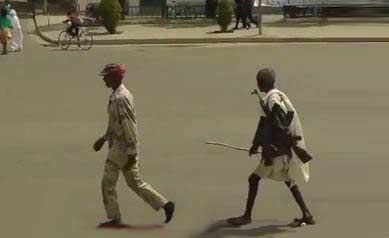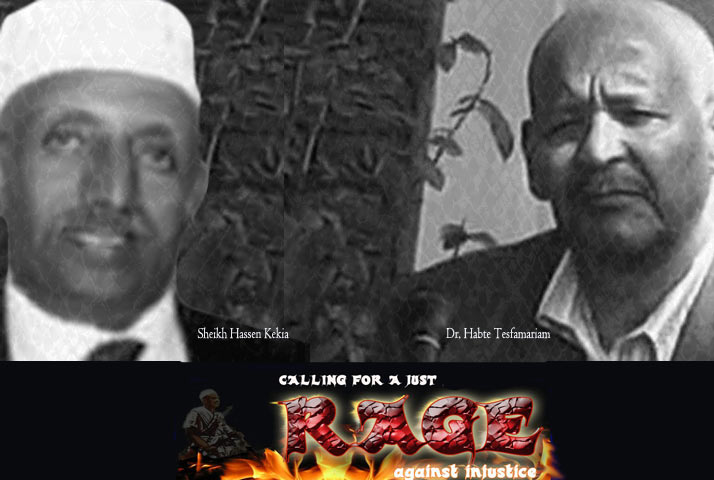The ENCDC Congress At Hawassa: A Determination To Succeed (Part I)

I reached Hawassa with a late group. It was late evening when our bus arrived there on the 22nd of November—and we were given a warm official reception at the entrance of the city. Our group included youth from Switzerland and refugees from the camps in Ethiopia and a few from other parts of Europe. For a passengers in our group, the trip brought back 20-years old memories—the last time he was in the town was in May 1991 as an imprisoned EPLF combatant together with about 100 others. He vividly recalled the day Addis Ababa fell on 28th of May when prison authorities disappeared and he and the other prisoners gained their freedom. The inhabitants of the town and the region included Eritreans who lived there and they took care of them until they were taken back to Eritrea. Now that the whole of Eritrea is imprisoned, it was very touching to watch him discuss ways and means to free it.
In order to be able to make an objective assessment and evaluation of the congress, one needs to look back at the background of the preparatory work, the venue, the events, the challenges faced and how they were tackled, the role of Ethiopia, and how all those factors affected the outcome.
The preparations
The Addis Ababa conference (ملتقي or waelaa) of 2010 elected a 53-member commission and entrusted it with a clear mandate to hold a general congress based on the papers that were discussed there. The EDA (Eritrean Democratic Alliance) invited for and prepared the 2010 conference and it deserves the credit for holding a conference that broadened the base of the opposition—including civil society and individual activists who were not affiliated with the political organizations. Thereafter, the commission did a remarkable job: it prepared 4 documents in time, established support groups all over the world, transparently and openly discussed the papers and enriched them with comments. Finally it held the congress in relatively good time.
The commission held tens of meetings and collected 3,5 million Birr from the public, while it received about half a million Birr in cash from Ethiopia. It also decided that congress participants should pay for their air-tickets and other transportation costs. This financial decision was a big step forward in terms of owning the whole exercise though there will always be need of help from our generous neighbors. The exercise proves that there is a great potential in the disposal of Eritreans if tapped properly. But the road was not paved with roses.
There were many challenges along the way: the relationship between the commission and the EDA (and the other political organization) has not been clearly articulated and that resulted in tensions which manifested in the form of delaying the congress by one month. Meanwhile, many new political organizations mushroomed just before the days of the congress and they were accepted by the commission without any clear criteria. Some may be credible organizations that challenge the regime, but many are just one or two-person outfits looking for a short cut to the leadership positions.
Close to 40 % of the participants were directly elected by the public while about 30 % were elected by the political organizations within the EDA and outside it. The rest were filled by the quotas given to youth, women, civic societies, veterans and prominent individuals invited with the hope of reflecting the Eritrean diversity. As there were no clear criteria, some of those elected by the public were members of political organizations—and that increased the quota of the political organizations who made use of it to increase the number of their representation—though it is important to note that some members of the political organizations in the Diaspora were among the most active members of the support groups.
Though the intention may have been to keep a balanced and diverse participation, in reality, some groups were overrepresented—and that clearly reflected the challenges that congress faced. The participants cannot claim that they represent the whole of Eritrea, but to a large extent they clearly reflect its diversity. It was with this background that the congress convened.
Those who attended the congress were those who supported it and those who became convinced along the way that it was a necessary exercise. They were those who actively oppose the regime, whether they are members of political organizations or not. Those who did not support the congress, and those who are against any close relationship with Ethiopia (the regime supporters and individuals who are closer to the regime than the opposition—the meskerem.nets and it satellites, and all those who do not recognize Eritrean diversity) cannot in any manner try to discredit the congress by claiming that our diversity was not reflected in the leadership or that there was no public participation. The issue of Daniel Tewolde just prior to the congress, gave the congress a little shaky start.
It is always easy to criticize in hindsight. The papers that were presented at the congress could have been made shorter, more precise and more focus could have been on the means of struggle (tactics and strategies) and on how to bring a democratic regime change in Eritrea. Also missing were some important documents assessing the current situation, defining the regime, as there were views clearly stipulating the enemies and allies and those in between, so as to design strategies on how to win more people. The congress could have made use of the strategies that were designed to address the media, the Diaspora and the youth at the seminar that was held in Addis Ababa in September of 2011. In no way should this be considered an undermining of the efforts exerted and time spent on preparing the various documents and discussing them. Its importance lies in what we can learn from it for the future.
The number of the participants, though it was beneficial to have so many people to attend, one can argue it could have been much lesser without compromising the diversity and the meetings could have been more effective. But the high number has its advantages and disadvantages. It can be argued that having larger numbers of people gives new faces to attend, thus giving the struggle new blood. It also offers an opportunity for more interaction and helps prepare and identify future leaders.
The venue
By design or by chance, the venue was the capital of the Southern Nations, Nationalities and Peoples’ Region (SNNPR) and it has excellent and superb facilities that accommodated such a big gathering. Politically, it represented the future we aspire to: an Eritrea where we can cherish, respect and enjoy our diversity and live at peace with each other and focus on improving the economy. Hawassa’s past relates to the current status of Eritrea which is ruled by a brutal dictatorship based on a one-people, one- language, one-cultural hegemony—just like in the case of Ethiopia under Haile Sellasie and later the Derg.
Before the EPRDF took power, the region was socially and economically one of the most disadvantaged areas in Ethiopia. People were even ashamed of their identity and changed their names to sound like those of the ruling class. As Hawassa has reclaimed its original name, in future democratic Eritrea, we spire to reclaim our identities, our old names, our history… and we will thrive. The few days that we stayed there taught us a lesson: if 56 nationalities and nations could live in peace and harmony, and thrive economically, why would we be scared that our different nationalities could live in peace and harmony, if their rights are respected constitutionally! Just like the SNNPR’s slogan, we will be more determined to echo, ‘Our diversity our beauty, our beauty our unity.’
The genuine and spontaneous warm reception given to us by the inhabitants was very touching. Hawassa with its rift valley lake is a tourist hub thanks to its many high class hotels, friendly people, and a warm environment—it deserves a visit. The food at the Haile Resort was varied, delicious and was served on time despite the large number of guests. When things tensed and the congress dragged on, a veteran opposition leader recalled Alamin Abdullatif’s song: ‘Seb ni khebdu teray ikonen vi nebir…’- people do not live just to eat. The venue provided the participants with a very conducive atmosphere to focus on issues of the congress.
Hawassa is about 270 Kms. Away from Addis Ababa and it n be reached by road in about 3 ½ hours; and we witnessed so much development along the road. In such a fast growing economies, perhaps the biggest challenge is combating corruption.
Thank you SNNPR. Thank you Hawassa for hosting the congress and for providing us with a valuable lesson on diversity. I also take this opportunity to thank the organizers for selecting Hawassa as a venue for the congress; it was an excellent choice. And on the way back to Addis Ababa, we were invited for lunch by the Oromiya Regional State Government at Adama (formerly Nazret) where Mr. Abdullaaziiz Mahaammad, the vice-President of the Government gave us a warm reception.
The deliberations
As security of the congress was important, primarily for the safety of the participants, it took some time to register the large number of the attendants whose pictures were taken in order to prepare identification badges for them. As participants had paid for their own tickets, some uninvited individuals arrived at the venue to attend. This caused extra cautious in scrutinizing the participants and thus security was tight, but friendly. The purely procedural matters in the opening ceremony: checking the attendance, discussing the by-laws that govern the process of the congress. These are what took more time than necessary; but running the congress of around 600 attendants is not an easy task.
In the middle of all of that, conspiracy theories started to circulate claiming that there were forces who want to delay the congress so they can push through their agendas at the last minute. But the rumors evaporated as the congress started in a normal pace. The election of the 27-member secretariat to manage the congress raised representation issues in relation to Eritrean diversity. The issues highlighted some of our weaknesses on how we see and define diversity and how we view hegemony and exclusion. Few wanted to take us back to the narrow language of the forties and fifties.
Diversity is a much wider concept. The Muslims/Lowlanders are ethnically a very diverse group. The Highlanders/Christians also have their regional and denominational diversity issues. There are those who believe in traditional religions. There is also gender and age-group diversity. It is important that we always stay keen to reflect our diversity in the entities that we elect, irrespective of majority or minority votes, without compromising the quality of the end result. The positive aspect of the congress was that people were elected based on merit, not based on the group they belonged to. Determined to succeed, the congress attendants overcome the hurdles and moved forward to the real issues.
The congress was divided into 7 groups to discuss the papers presented by the commission. These included a National Political Charter, which is a contract on the political, economic and social goals, and programs that would lead us during the struggle for democratic change and the transitional period following the collapse of the Eritrean regime. The Road Map describes the coordinated mechanisms that should be used to bring about a democratic change in the political affairs, mobilizing people, media, diplomacy, economy, military and security affairs during the struggle period and immediately after regime change so that no vacuum is created. Another paper related to the size, structure and functions of a united opposition leadership that would be elected by the congress. These papers were discussed thoroughly and approved after improvements were made to them. As for the draft constitution for the transitional period, it was referred to the national council to be reviewed by experts and used as a reference document in the process of drafting a new constitution in Eritrea. These papers were available to the public at www.encdc.com prior to the congress. How we handled the issue of the draft constitution highlighted the maturity of the participants and their determination to succeed. There were some who saw that it was not the mandate of the congress to discuss a constitution, while many others saw that it was within the right of the congress to come up with a draft document.
Reflecting on the discussions, I personally feel that the main differences of opinion since the forties is on the issue of diversity: how do we define it? How do we view it, how do we want to manage it? And how do we relate it to our own group interests?
We have come a long way on this issue since the formation of the Eritrean National Alliance (ENA) and the discussions we had at the 2010 congress in Addis. The presence of the nationality-based organizations, the decentralized system of governance, the issue of self-determination which were considered taboo subjects a few years ago have now become part of the Eritrean political discourse. Yet, we need to work more on that. There are those of us who still believe that a centralized system of government, like the current one: ‘hade hizbi hade libi’ (one people, one identity) best protects their interests. Some genuinely believe that a democratic centralized system protects the unity of the country.
It is important that we look at our diversity as a blessing and that the more we manage our diversity, not only in theory but in practice, and on the recognition of rights and on a decentralized system, we will have far-lasting peace and development. We need to see that as a tool to protect the interests of all entities equally. As far as I am concerned, the draft transitional constitution presented at the congress (despite its flaws and questions about its legitimacy) is the first of its kind that addresses the issue of diversity and how we can manage it.
Here are my observations that I thought are worth mentioning. Almost every one wants to speak even if only to repeat what was already said. It also seems that we have produced cadres who have become experts in just procedural points such as point of order, clarification, question, addition, etc. It is difficult to pursue discussions with such unnecessary hindrances. Some abuse these procedural points just to be able to get the chance to speak believing that they have the best solutions and feel they have the right to be heard whenever they raise their hands.
To be continued….
In Part II, I will look into the process of electing the leadership, the role of Ethiopia, the positive aspects and the shortcomings of the outcome and the way forward.



Awate Forum